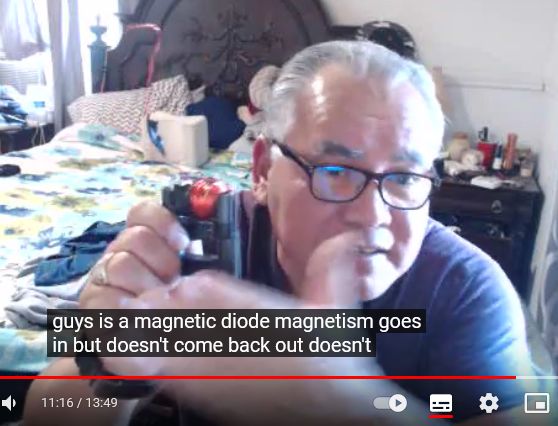Alex Manzanero - Secret of lenz free coil

Alex Manzanero
Secret of lenz free coil
Anti lenz coil proof
Hi Warren
I looked at more videos from the spanish guy who
came up with this idea. I went to link by Hermes, and went to the guys channel and he
did test this out, plus some people in comments did too and it seems to work, however
the gap needs to be adjustable in its distance for the particular load. As with too
big of gap it doesnt work, Alex said that a piece of duct tape worked well for that
gap.
There is a guy with video testing it with a bedini motor already. he is
one who said gap needs to adjustable. Also it seems the rotor magnets need to whip by
the upper half of it, not sure about that. Looks like you test model should work give
it a try, rotovertor is best to check no lenz generators Hector would say.....very
sensitive to shaft load. Anyways go to Alex's you tube channel and look through the
tests done already by other people and him.
Kone
Warren
That
particular configuration works for generator coils. See the many videos of
MrAnguswangus on
YouTube. Look at
Peter Lindemann's attraction motor.
He uses EXACTLY this concept to build a motor that has NO BACK EMF.
There is a
simpler way. ANY and EVERY coil is Lenz free at the correct frequency. By this I mean
the speed at which the magnet passes the coil. This needs to be a CONSTANT SPEED to
talk about Lenz realistically. Why? Because Lenz is NOT a law. Lenz is simply a
REACTION. Examine what happens with a standard coil under load. As the rotor magnet
approaches the core of the coil it is FIRST attracted to the core. SECOND, the magnet
induces a magnetic field in the core material that is EVENLY DISTRIBUTED. This flux
must build up to the point where THIRD, electricity begins to be generated in the
wire, and that electricity must accumulate to the point where it will FOURTH, turn the
core material into an electromagnet repelling the approaching magnet. These actions
take TIME!!!! FOUR things must happen before Lenz occurs. Four variables. Affect any
ONE of them and you affect Lenz.
What happens if the core is two feet long?
There is never enough flux accumulated (because it is evenly distributed) in the core
to generate electricity in the wires to the point where polarity of the core material
is changed and repels the approaching magnet. Reduce the length of the core material
to JUST THE RIGHT LENGTH for the RPM at which the rotor is turning, and the moment
when Lenz occurs can be delayed to where it neither speeds up the prime mover, nor
slows it down. This is "Lenz neutral". How else can it be affected? The RPM of the
motor can be increased to "outrun" the Lenz reaction. That is the simplest method. Or
you add more wire to the coil to increase its capacitance. Or you wind strands in
parallel and then connect them in series to increase the capacitance as Tesla did with
his "Tesla coil". Or you add the correct capacitor across the coil, increasing its
"capacitance", because the capacitor will fill up FIRST, before the coil does, and
delay the windings accumulating the electricity necessary to affect the core material.
On my generator I have coils composed of three strands 1,000 feet long of #23
AWG wire. With twelve 3/4" diameter magnets on a 10.5" rotor, the required RPM is
2800.
https://www.youtube.com/watch?v=f-AuRDqQecA
But Lenz neutral does NOT get
you there! It is great if you want a BARELY COP>1 system with only a couple coils on
it so you can brag to your friends and have something on the bench to show. You can
build a really little one for THAT! The other issue is that every magnet on your rotor
must go by the core material of every coil you have. There is an attraction there that
affects the prime mover and must be overcome. If you have more than three or four
coils, you will burn up your prime mover if you have cores/coils and rotor magnets of
any consequence. My generator addresses that. Here is a video of using magnets to
increase the field strength of the generator coil and the motor coil. The IMPORTANT
part of this video is when I use the hand held magnet to NEUTRALIZE the attraction the
generator coil core has to the rotor magnets passing it. I move an N magnet closer to
the N rotor magnet to offset the N rotor magnet directly opposite's attraction to the
iron core of the generator coil. Remember, since the generator core is NOT a Lenz free
coil in this case, there is attraction, then repulsion, then attraction again. In my
BIG generator (Lenz NEUTRAL) there is just ATTRACTION, so my repulsion magnets work
even better. The offsetting magnet allows the prime mover to speed up to the speed it
SHOULD be going and WOULD be going with no generator coil in place. With little coils
like this, the differences are easier to see.
https://www.youtube.com/watch?v=P0bMRdHGXM8
David Bowling
back to linkpage
suggestion
read and sign my guestbook

